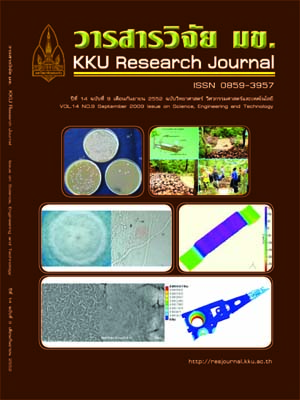Preparation of Fe-RH-MCM-41 for arsenic removal (Thai)
Main Article Content
Abstract
Arsenic solution (As3+ and As5+) was treated by adsorption on Fe-RH-MCM-41 mesoporous material synthesized from rice husk. This study compares the synthesis methods of Fe-RH-MCM-41 via Direct Hydrothermal Synthesis (DHT) and Template Ion-exchange (TIE) at different Si/Fe molar ratios (100, 50, 10, 0, and α) on the arsenic removal efficiency. Characteristics of the synthesized adsorbents were determined by X-ray diffraction (XRD), X-ray fluorescence (XRF), and Brunauer Emmett Teller (BET). The arsenic removal efficiency was determined from the batch experiment at concentration of 500 µg/l. It was found that TIE10 gave the best performance at removing both As3+ and As5+ at pH 4. The maximum adsorption capacity of As3+ by TIE 10 was 69.66 µg/g, while the adsorption capacities of As3+ and As5+ on TIE 10 and DHT 10 were not significantly different. The Fe-RH-MCM-41 synthesized by the TIE method exhibited better performance for both arsenite and arsenate removal than that synthesized by the DHT method. This is dependent on the mechanism of iron impregnated in the MCM-41 structure.


